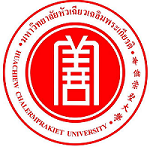Please use this identifier to cite or link to this item:
https://has.hcu.ac.th/jspui/handle/123456789/3710| Title: | Discovery of novel coumarin triazolyl and phenoxyphenyl triazolyl derivatives targeting amyloid beta aggregation-mediated oxidative stress and neuroinflammation for enhanced neuroprotection |
| Authors: | Satsawat Visansirikul Suthira Yanaso Yingrak Boondam Kanjanawadee Prasittisa Brompoj Prutthiwanasan Sumet Chongruchiroj Kittisak Sripha ศาศวัต วิศาลศิริกุล สุธีรา ญานะโส ยิ่งรัก บุญดำ กาญจนาวดี ประสิทธิสา บรมพจน์ พฤฒิวนาสัณฑ์ สุเมธ จงรุจิโรจน์ กิตติศักดิ์ ศรีภา Mahidol University. Faculty of Pharmacy Huachiew Chalermprakiet University. Faculty of Pharmaceutical Sciences Mahidol University. Faculty of Pharmacy Nakhon Phanom University. Faculty of Education Mahidol University. Faculty of Pharmacy Mahidol University. Faculty of Pharmacy Mahidol University. Faculty of Pharmacy |
| Keywords: | Coumarin triazolyl คูมาริน-ไตรเอโซล Neuroinflammation กระบวนการอักเสบในระบบประสาท Inflammation การอักเสบ Neuroprotection อาการเส้นประสาทอักเสบ Phenoxyphenyl triazolyl |
| Issue Date: | 2024 |
| Citation: | RSC Med. Chem. 8,15 (2024) : 2745-2765 |
| Abstract: | This study involved designing, synthesizing, and evaluating the protective potential of compounds on microglial cells (BV-2 cells) and neurons (SH-SY5Y cells) against cell death induced by Aβ1–42. It aimed to identify biologically specific activities associated with anti-Aβ aggregation and understand their role in oxidative stress initiation and modulation of proinflammatory cytokine expression. Actively designed compounds CE5, CA5, PE5, and PA5 showed protective effects on BV-2 and SH-SY5Y cells, with cell viability ranging from 60.78 ± 2.32% to 75.38 ± 2.75% for BV-2 cells and 87.21% ± 1.76% to 91.55% ± 1.78% for SH-SY5Y cells. The transformation from ester in CE5 to amide in CA5 resulted in significant antioxidant properties. Molecular docking studies revealed strong binding of CE5 to critical Aβ aggregation regions, disrupting both intra- and intermolecular formations. TEM assessment supported CE5's anti-Aβ aggregation efficacy. Structural variations in PE5 and PA5 had diverse effects on IL-1β and IL-6, suggesting further specificity studies for Alzheimer's disease. Log P values suggested potential blood–brain barrier permeation for CE5 and CA5, indicating suitability for CNS drug development. In silico ADMET and toxicological screening revealed that CE5, PA5, and PE5 have favorable safety profiles, while CA5 shows a propensity for hepatotoxicity. According to this prediction, coumarin triazolyl derivatives are likely to exhibit mutagenicity. Nevertheless, CE5 and CA5 emerge as promising lead compounds for Alzheimer's therapeutic intervention, with further insights expected from subsequent in vivo studies. |
| Description: | สามารถเข้าถึงบทความฉบับเต็ม (Full Text) ได้ที่: https://pubs.rsc.org/en/content/articlelanding/2024/md/d4md00270a |
| URI: | https://has.hcu.ac.th/jspui/handle/123456789/3710 |
| Appears in Collections: | Pharmaceutical Sciences - Artical Journals |
Files in This Item:
| File | Description | Size | Format | |
|---|---|---|---|---|
| Discovery-of-novel-coumarin-triazolyl-and-phenoxyphenyl-triazolyl.pdf | 84.31 kB | Adobe PDF | View/Open |
Items in DSpace are protected by copyright, with all rights reserved, unless otherwise indicated.
